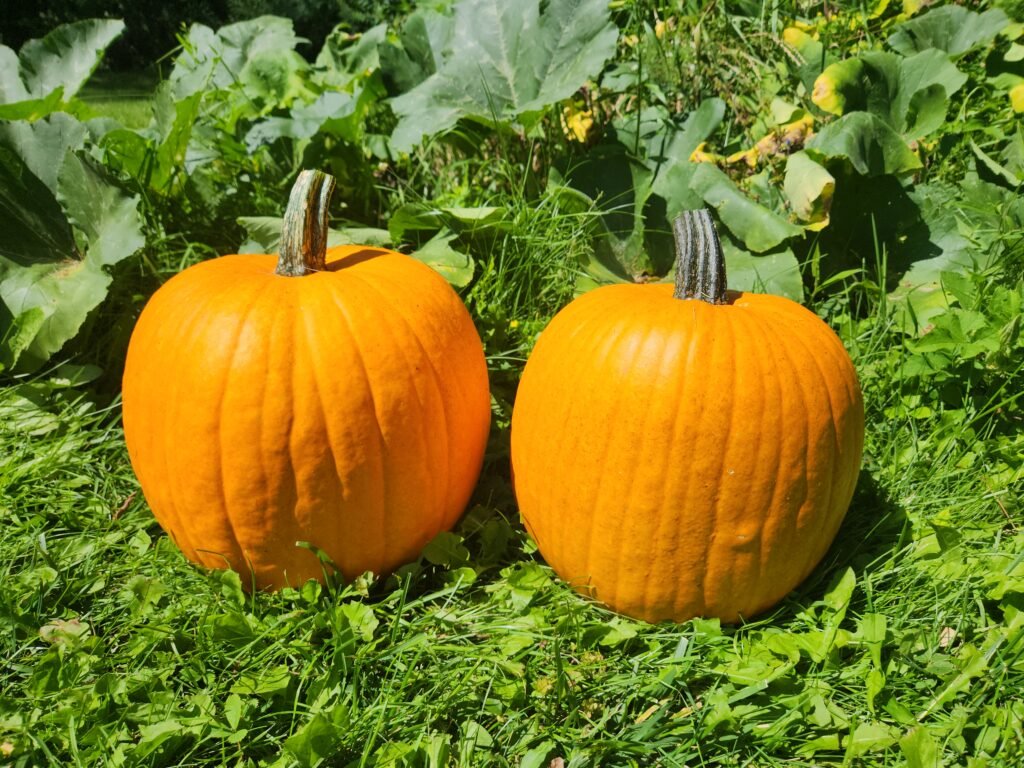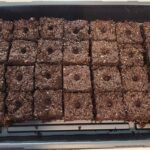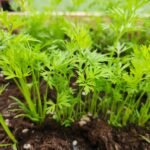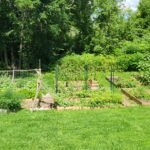We’ve been growing pumpkins for a few years now and we will continue to grow them every year in the future. Pumpkins are a great source of nutrients from both the flesh and the pumpkin seeds. Even if you don’t plan on eating the pumpkins they make for great fall decorations as well. We like to multi purpose our pumpkins. We use them for decorations or for carving jack-o-lanterns and we roast the seeds for snacks and turn the flesh into pumpkin puree. So how do you grow a pumpkin? Let us walk you through the each step to grow a beautiful pumpkin of your very own.
This post contains affiliate links. If you use these links to buy something we may earn a commission. Thanks.
What Kind Of Pumpkin Should I Grow?
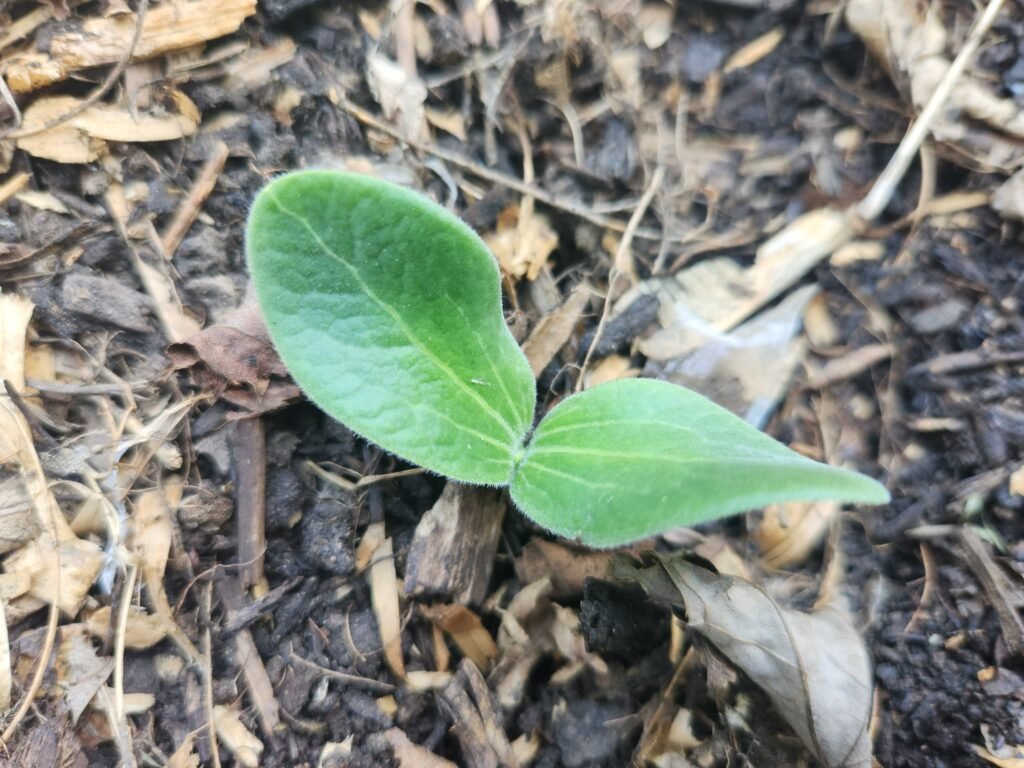
Selecting your pumpkin variety can seem like a daunting take. There are so many pumpkins and squash in the Gourd family (Cucurbits) that you might get overwhelmed. The best way to pick your pumpkin variety is to think of what you want to do with it. Do you want to use the pumpkin for cooking? Carving? Decoration? All of the above? That will help narrow down your selection a great deal.
Best Pumpkins For Cooking:
The best type of pumpkins for cooking are generally the smaller varieties. The large pumpkins used for carving have more of a stringy flesh and while they can still be eaten and are delicious, for the best results small pumpkins work the best. We can recommend some, but there is going to still be some decisions to be made. A few of the better cooking pumpkins are:
- Pie Pumpkins: Also known as sugar pumpkins are small and round with sweet tasting flesh.
- Casper: This pumpkin also has delicious sweet flesh under its white skin.
- Cherokee bush: With its golden-yellow flesh this pumpkin is perfect for pies and breads.
Best Pumpkin For Carving:
A good pumpkin for carving needs to be fairly large and have a nice shape to it. Again, there are several types that are well suited to being carved for Halloween and they are:
- Field pumpkins: Field pumpkin is more of a general term for what kind of pumpkin it is. You will find a few varieties that are labelled “Field Pumpkins” and they will all do very well for carving. We grow a variety called “Connecticut Field” and it is a wonderful variety.
- Jack-O-Lantern: Yes there is a variety of pumpkin called for exactly what you want it for. The Jack-O-Lantern variety of pumpkin grow tall and round with a large almost flat sides to them. Ideal for carving whatever you like into them.
If you’re not looking to cook or carve your pumpkins and simply want some nice decorations for around your house then you can’t go wrong when picking a variety to grow. There are so many options on sizes and colours that pumpkins come in. You really have almost unlimited choice.
How To Plant Pumpkins:

Since pumpkins are part of the Cucurbita family. This family includes squashes (both summer and winter), pumpkins, gourds, melons and cucumbers. As with all members of this family pumpkins need a large area to grow out their vines to produce both male and female flowers and ultimately, fruit. Lets dive in and look at how to best plant your pumpkins seeds.
Can You Start Pumpkin Seeds Indoors?
Yes you can! Pumpkins can be started indoors but they don’t need as much time as with other fruits and vegetables. Pumpkin seeds are large and when they germinate they grow very rapidly. Because of this, they will outgrow their small pots in no time and will need to be transplanted outside in no more than 3 weeks. There are definitely benefits to starting your pumpkins indoors though. A pumpkin seedling is very tender and susceptible to being eaten by insects and slugs. Starting your pumpkin indoors and giving it a few weeks to grow allows it to start to grow the customary thorns on the side of the vine to protect itself from anything try to eat it.
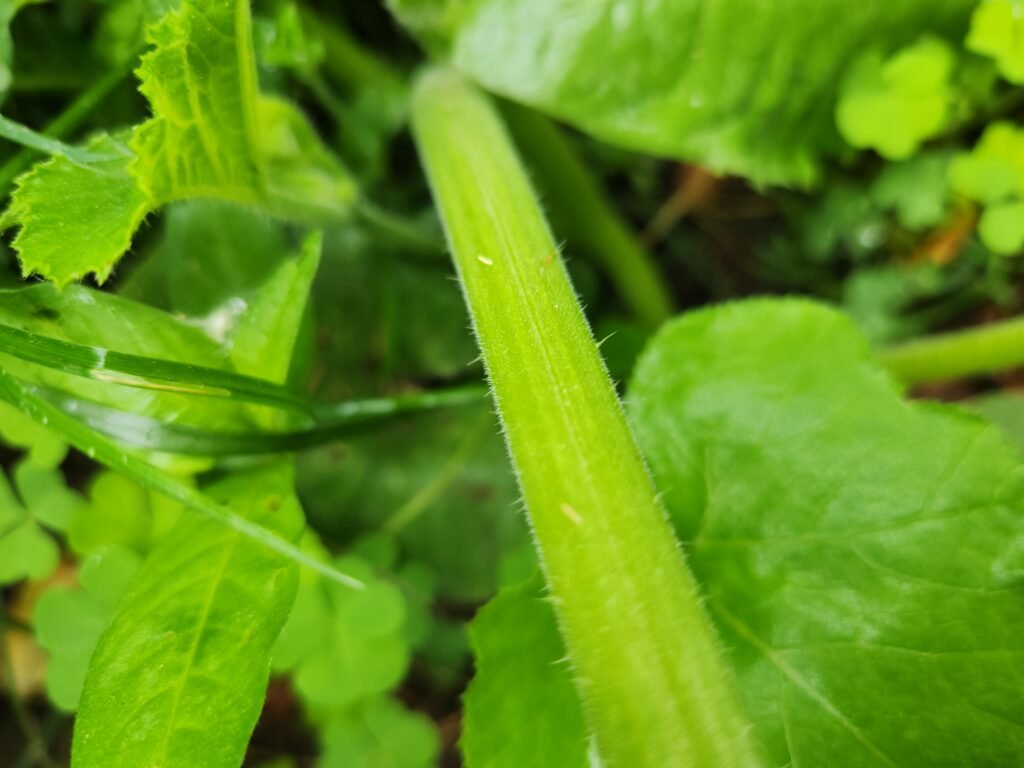
When Should Pumpkins Be Planted?
Pumpkins require warm weather, and as such they need to be planted after the risk frost has passed in your area. Whether you are direct sowing or transplanting seedlings you need to wait until it is warm enough. When looking up your last frost date where you live remember that it is only a guide and it is better to wait another week or two and watch your local weather forecast before planting outside. If you plant to early and there is a frost you run the risk of your plants dying.
How Much Space Do Pumpkins Need?
Pumpkins like all squashes require a lot of space. They will grow out long vines that will continue to grow for the entire growing season. Pumpkins need to be planted a minimum of 3-4 feet (36-48 inches) apart. While that seems like a lot of space, remember that these plants will grow to be 30 or 40 feet long with large leaves. Wherever your pumpkins start when they are planted they will take over entire areas of your garden as they grow so make sure there is also room for them beside the garden they are planted in.
What Kind Of Soil And Sun Requirements Do Pumpkins Have?
Pumpkins like loose well draining soil with a soil pH between 6.0 and 6.8. We use this soil tester to make sure our soils pH is in the right area. Pumpkins also require at least 8 hours of direct sun every day. So make sure to pick a sunny spot in your garden to grow your pumpkins.
What Are Good Companion Plants For Pumpkins?
The best and most common companion plants for pumpkins are corn and pole beans. These 3 plants have the nickname of the “three sisters” when they are planted together. If you are going to plant the three sisters they need to be planted in a specific order. Plant the corn first, then the beans, and then pumpkins. These work well together because the corn grows up tall, the pole beans use the corn as a trellis as it grows up and the pumpkins grow along the ground acting as a living mulch.
Do Pumpkins Need To Be Planted On A Hill?
Pumpkins do not require a hill for them to grow but it can be beneficial. Using a hill to plant your pumpkin seeds can help because the hills of soil will warm up quickly in hot weather and speed up the rate of germination. Pumpkins like warm weather and can be sensitive to the cold so hills can help in that regard. We’ve never personally used a hill for growing our pumpkins but it is a tried and true method that could help with your yield.
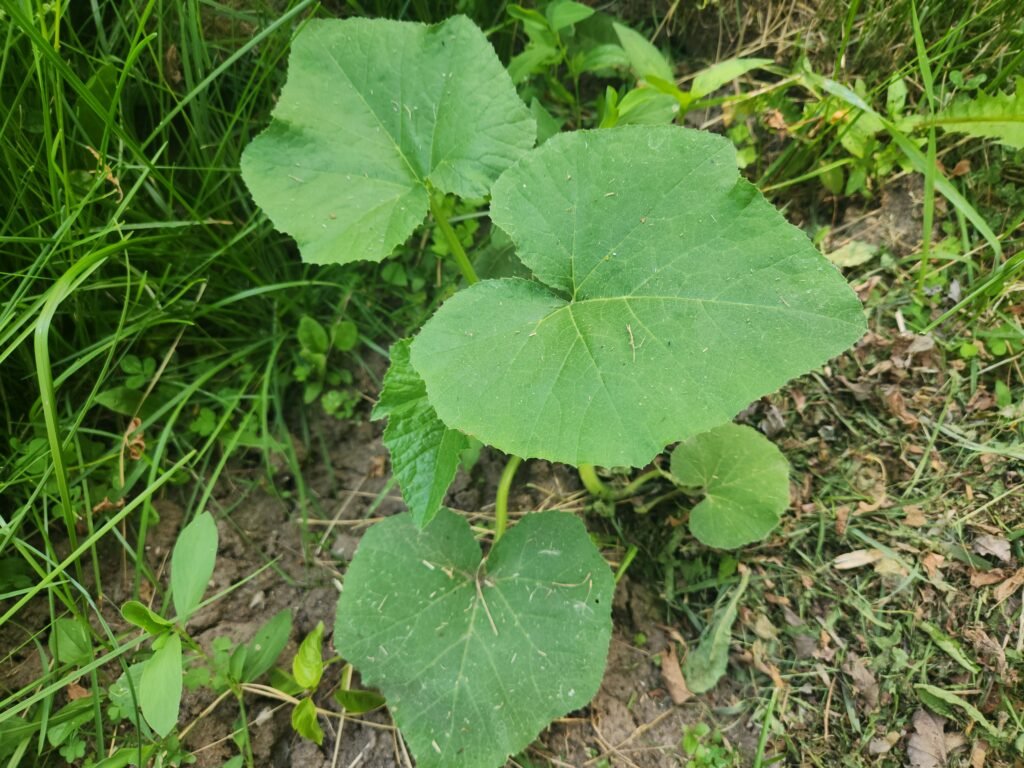
Pumpkin Care Tips:
How Much Water Do Pumpkins Need?
Pumpkins need an average of 1 inch of water per week in normal conditions. If it is very hot and dry they may need more as required. Also, when the plant is fruiting it is beneficial to give the plant a little bit extra water each week.
Should You Fertilize Pumpkins?
Pumpkins need lots of nitrogen, phosphorous, and potassium. Ideally they will get most of their nitrogen early in the year and more phosphorous and potassium later on in the season.
What Are The Main Pests For Pumpkins?
When the plants are young a main pest for your pumpkins are going to be snails and slugs. These will be less of a problem once the plant establishes itself as they do not like the plants thorns. The Squash Vine Borer is another common pest of pumpkins.
How Do You Hand Pollinate Pumpkins?
First you need to identify a male and female flower. This is easily done by looking directly behind the flower head and seeing if there is a fruit attached or a long branch going back to the main stem.
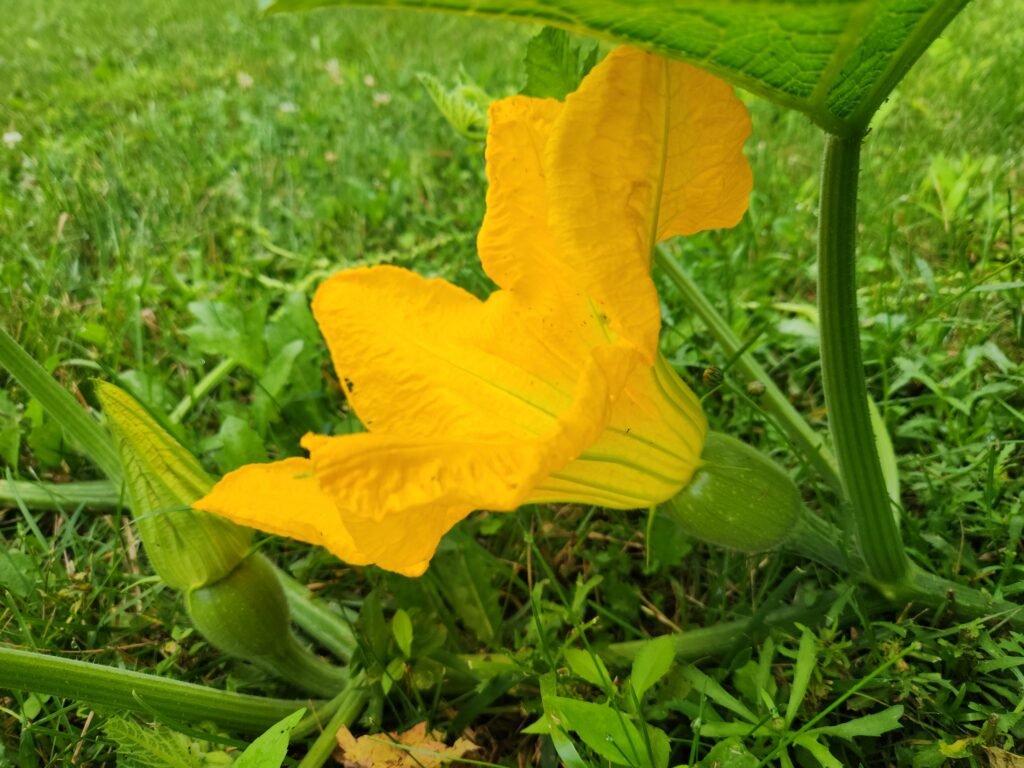
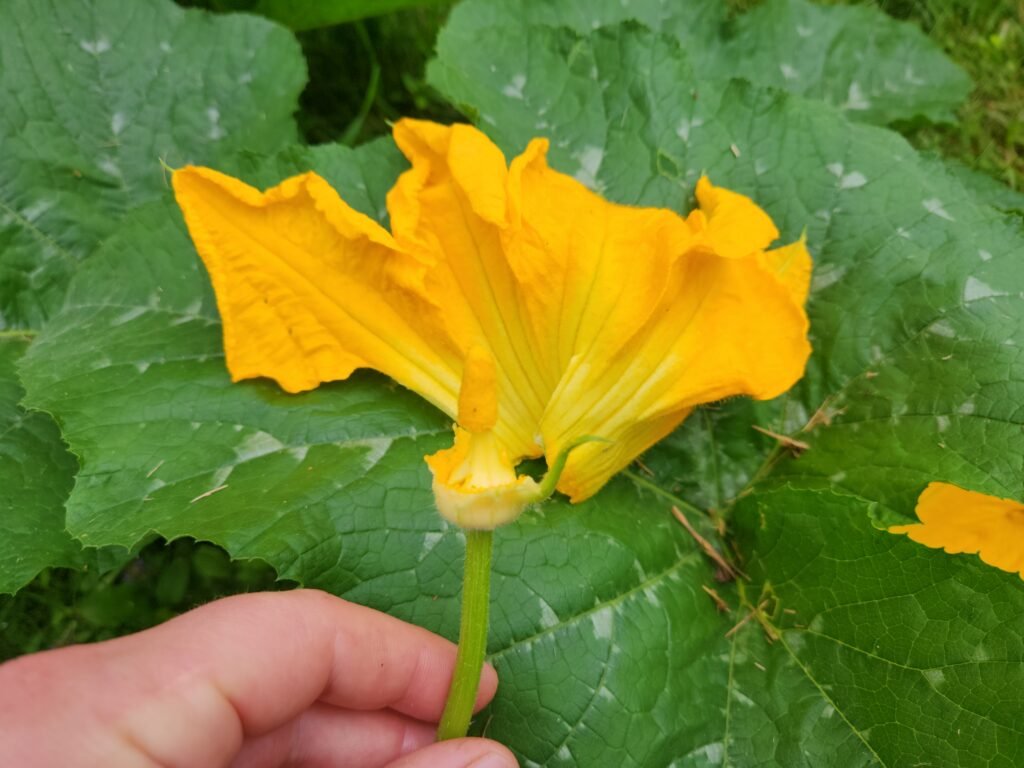
To make sure pollination is successful we need to carefully remove the pedal from the male flower and use it to pollinate the female. This can only be done when the female flower is open during the morning. Take the male flower and gently brush it up against the middle of the female flower being sure the get it all over.
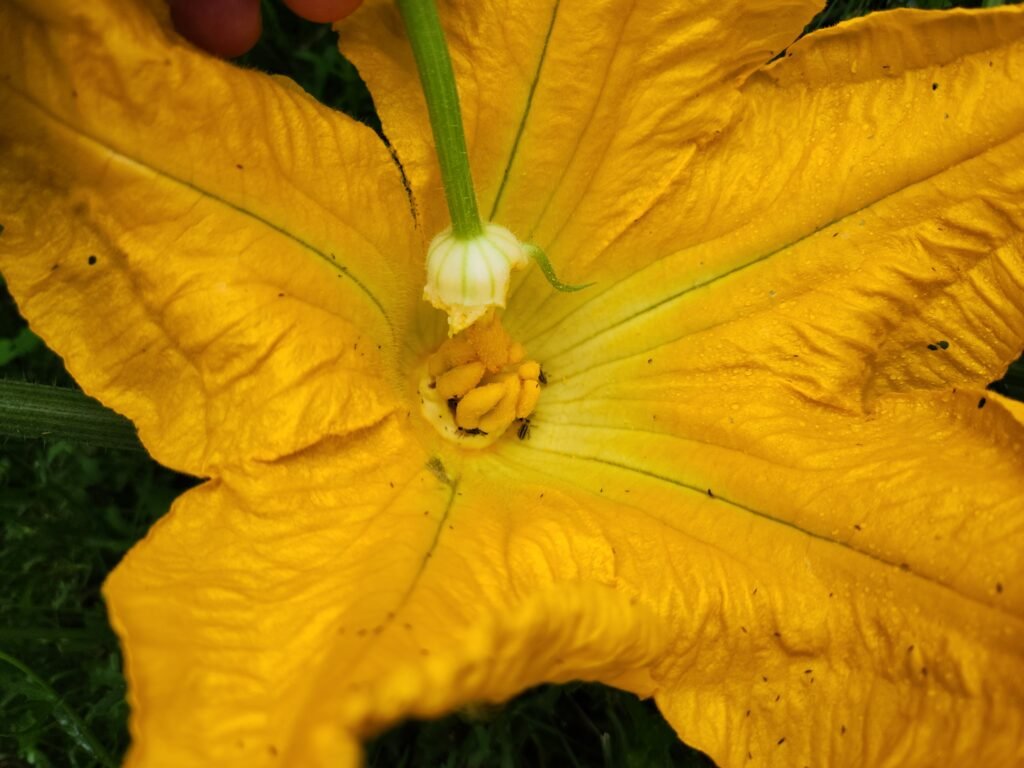
Hand pollinating is a good idea to make sure that your female flowers are getting the pollen from the males. Most likely it’s not necessary but it definitely won’t do any harm.
Harvesting Pumpkins:
We’ve got our pumpkins planted and taken care of, so how do we go about harvesting them. Lets take a look at a few things we need to consider.
How Do You Know When A Pumpkin Is Ready To Be Harvested?
Most pumpkin varieties take anywhere from 100 to 120 day to harvest. That means you’ll be waiting almost 4 months from the time you sowed your seeds until you can finally retrieve your first pumpkin. Tell if a pumpkin is ready to be harvested by looking at the skin and stem. The pumpkin should be fully coloured if there is some green left on the skin of the pumpkin it is not ready. The rind should also be firm to the tough, if your fingernail easily punctures the skin, it is not ready.
I made a short video describing how to know when to harvest pumpkins. It can be viewed here https://www.youtube.com/shorts/yeeRLQ3r46Q.
The stem is another good indicator of when a pumpkin is ripe for the picking. When growing the stem is green and soft. Once the stem starts to harden and become a more dark green/brown colour you know the pumpkin is ready.

How Do You Cure A Pumpkin?
Once you’ve picked your pumpkin you might still need to cure it. If you’re planning on using your pumpkin for cooking or carving right away you can skip the curing process. But if you want your pumpkin to sit around for a little while before you use it you’ll need to cure it first.
For and in depth look at curing pumpkins and other winter squash check out our How To Cure Winter Squash article.
Curing the pumpkin or any squash hardens the rind so it will stay fresh longer. To cure a pumpkin place it in a hot environment for a few weeks. A common place for curing is in the garden where it grew. You’ll need to remove all the plant matter and leave the pumpkins in the garden by themselves. Sitting in the sun on the hot soil will speed up the curing process. Make sure you rotate your pumpkins daily for even exposure to the sun.
Another alternative if you have it, and this is what we use, is a greenhouse. Simply put your pumpkins on the floor of the greenhouse for at least a week and they will be good to go.
Pumpkin Recipes:
We have a couple of go to pumpkin recipes we use every year. Our favourite is our oven roasted pumpkin seeds recipe. Pumpkin seeds are not only good for you but they are delicious to eat with this quick 15 minute recipe.
Other favourite way to use the flesh of the pumpkin is to make our healthy chocolate pumpkin oatmeal bake recipe. This is great for breakfast and is a crowd pleaser with our children.
Frequently Asked Questions About Growing Pumpkins
How long does it take pumpkins to grow from seed to harvest?
Most pumpkin varieties take about 90 to 120 days to reach maturity, depending on the type you’re growing. Mini pumpkins mature faster (around 90 days), while large carving varieties can take closer to 120 days.
Can pumpkins grow on a fence or trellis?
Yes, smaller pumpkin varieties can be grown vertically on a sturdy trellis or fence. Be sure to provide slings or netting to support the fruit as it grows so the vines don’t snap under the weight.
Why are my pumpkin flowers falling off?
It’s normal for the first flush of male flowers to fall off since they don’t produce fruit. Female flowers, which have a tiny fruit behind the bloom, will only set pumpkins if they are pollinated. Poor pollination (from lack of bees or bad weather) can also cause flowers and small fruit to drop.
How many pumpkins will one plant produce?
This depends on the variety and growing conditions. Smaller varieties can produce 6–10 pumpkins per plant, while larger carving pumpkins usually produce 2–5 per plant. Good soil, water, and pollination will boost yields.
Do pumpkins come back every year?
No, pumpkins are annual plants. Once they finish producing and die back in the fall, they won’t regrow the following year. You’ll need to replant fresh seeds each spring.
Can I grow pumpkins in containers?
Yes, but only smaller varieties will do well in pots. Use at least a 15–20 gallon container, choose a compact or bush-type pumpkin, and be prepared to provide lots of water and fertilizer throughout the season.
Why are my pumpkin leaves turning yellow?
Yellowing leaves can be caused by overwatering, nutrient deficiencies (especially nitrogen), or pests like squash bugs. Older leaves naturally yellow later in the season, but younger leaves turning yellow usually signal a problem that needs attention.
Conclusion:
We hope you enjoyed this pumpkin growing guide. If you did make sure you check out the other growing guides, seed saving guides and our recipes. We are growing our website with more articles all the time, and we invite you to grow with us. Whether you’re a seasoned gardener or just starting out, growing pumpkins can be an enriching experience. If you have any questions or want to share your gardening journey, feel free to leave a comment below. Happy gardening!

